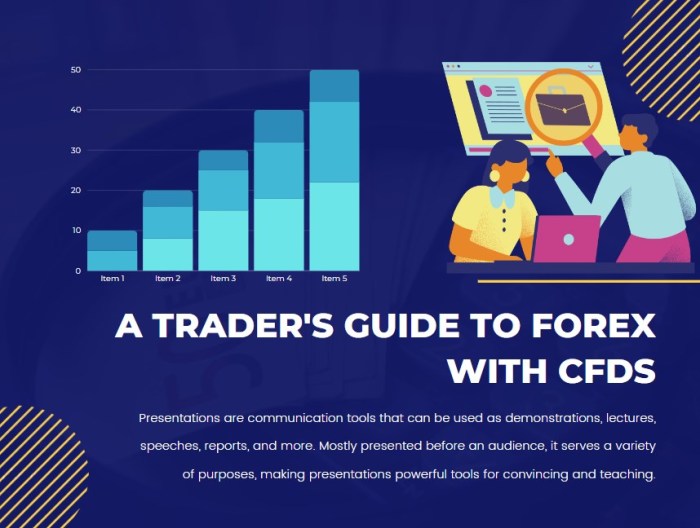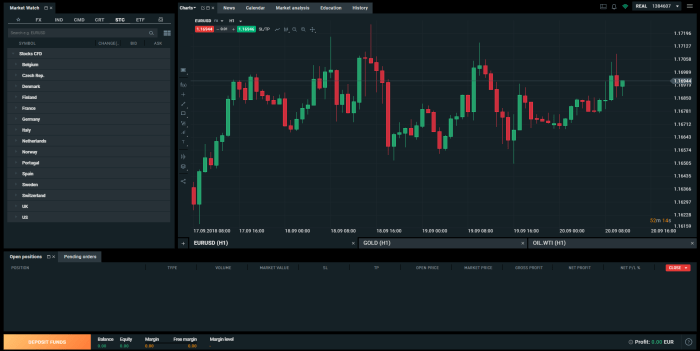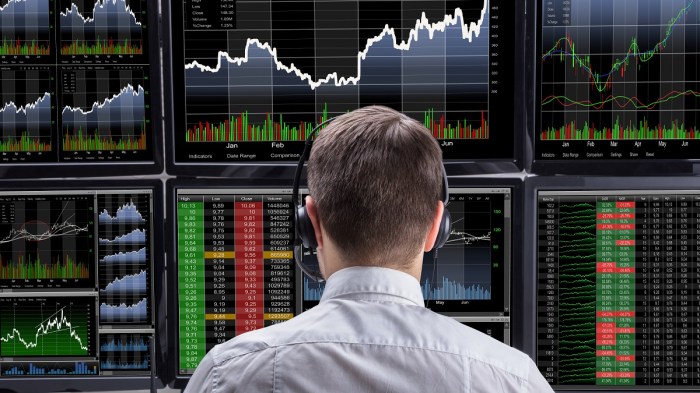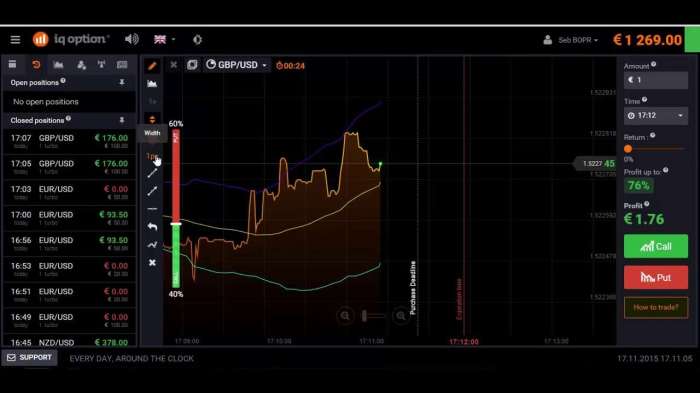
Trading CFD Forex: Dive into the thrilling world of currency and contract-for-difference trading. This isn’t your grandpa’s savings account; we’re talking high-stakes action, leveraging your capital to potentially ride the waves of global markets. But hold up – before you jump in headfirst, let’s break down the basics, the risks, and the strategies to navigate this exciting, and sometimes volatile, landscape. Understanding the fundamental differences between CFDs and Forex trading is key, as is mastering risk management techniques that can make or break your trading journey.
From choosing the right broker and platform to developing a robust trading plan that blends technical and fundamental analysis, we’ll equip you with the knowledge to approach CFD and Forex trading with confidence. We’ll cover everything from popular indicators and charting tools to different trading strategies, helping you tailor your approach to your risk tolerance and financial goals. This isn’t a get-rich-quick scheme; it’s a journey that requires dedication, discipline, and a healthy dose of understanding.
Introduction to CFD and Forex Trading
Navigating the world of online trading can feel like stepping into a whirlwind of jargon and complex strategies. Two prominent players in this arena are CFDs (Contracts for Difference) and Forex (Foreign Exchange) trading. While both offer opportunities for profit, understanding their key distinctions is crucial before diving in. This section will clarify the fundamentals of each, highlighting their differences and inherent risks.
Fundamental Differences Between CFDs and Forex Trading
CFDs and Forex trading, while both involving speculation on price movements, operate in fundamentally different ways. Forex trading involves directly buying and selling currencies in the foreign exchange market, aiming to profit from fluctuations in exchange rates. Think of it like exchanging dollars for euros, hoping the euro strengthens against the dollar. CFDs, on the other hand, are contracts that reflect the price difference of an underlying asset (which can include currencies, stocks, indices, or commodities) between the opening and closing of the trade. You don’t actually own the underlying asset; you’re speculating on its price change. The key difference lies in ownership: Forex trading involves direct ownership of currencies, while CFD trading involves a contract based on price movements.
Risks Associated with CFD and Forex Trading
Both CFD and Forex trading carry significant risks. In Forex, these risks include currency volatility, geopolitical events impacting exchange rates, and the potential for substantial losses if your predictions are incorrect. Similarly, CFD trading exposes you to leverage risks (explained below), market volatility affecting the underlying asset, and the possibility of losing more than your initial investment. It’s crucial to remember that neither CFD nor Forex trading guarantees profit; substantial losses are a very real possibility. Effective risk management strategies, such as setting stop-loss orders and diversifying your portfolio, are essential to mitigate these risks.
Leverage in CFD and Forex Markets
Leverage is a double-edged sword in both CFD and Forex trading. It allows you to control a larger position with a smaller initial investment, magnifying both potential profits and losses. Forex brokers often offer leverage ratios of up to 50:1 or even higher, meaning you can control $50,000 worth of currency with just $1,000 of your own capital. CFD brokers also offer high leverage, sometimes exceeding the leverage available in Forex markets, depending on the broker and the specific asset being traded. While leverage can amplify profits, it equally amplifies losses, potentially leading to rapid account depletion if the market moves against your position. Therefore, using leverage requires a thorough understanding of risk management and a cautious approach.
Regulatory Landscape for CFD and Forex Brokers
The regulatory environment for CFD and Forex brokers varies significantly across different jurisdictions. This table provides a simplified overview; it’s crucial to conduct thorough independent research before choosing a broker. Regulations change frequently, so always check the latest information from the relevant authorities.
| Jurisdiction | Forex Broker Regulation | CFD Broker Regulation | Key Regulatory Bodies |
|---|---|---|---|
| United States | Regulated by the Commodity Futures Trading Commission (CFTC) and the National Futures Association (NFA) | Regulated by the CFTC and the NFA (depending on the underlying asset) | CFTC, NFA, SEC (for some instruments) |
| United Kingdom | Regulated by the Financial Conduct Authority (FCA) | Regulated by the FCA | FCA |
| Australia | Regulated by the Australian Securities and Investments Commission (ASIC) | Regulated by the ASIC | ASIC |
| Cyprus | Regulated by the Cyprus Securities and Exchange Commission (CySEC) | Regulated by the CySEC | CySEC |
Trading Strategies for CFDs and Forex: Trading Cfd Forex
Navigating the dynamic world of CFDs and Forex requires a robust trading strategy. Success hinges on a blend of technical and fundamental analysis, informed by a chosen trading style that aligns with your risk tolerance and time commitment. Let’s delve into the key elements that form the foundation of effective trading in these markets.
Technical Analysis Indicators in CFD and Forex Trading
Technical analysis utilizes price charts and indicators to identify trends and predict future price movements. Several popular indicators provide valuable insights. Moving averages, for example, smooth out price fluctuations, revealing underlying trends. A common strategy involves comparing short-term and long-term moving averages; a crossover can signal a potential buy or sell opportunity. Relative Strength Index (RSI) measures momentum, helping traders identify overbought or oversold conditions, suggesting potential reversals. Other indicators like MACD (Moving Average Convergence Divergence) and Bollinger Bands offer further insights into price volatility and momentum. The effective use of these indicators requires understanding their strengths and limitations and combining them with other analytical tools.
Fundamental Analysis in CFD and Forex Trading
Fundamental analysis focuses on macroeconomic factors that influence currency values. This involves examining economic data releases such as GDP growth, inflation rates, interest rate decisions, and employment figures. Geopolitical events, government policies, and central bank actions also play a crucial role. For example, a surprise interest rate hike by a central bank might strengthen its currency, while negative economic news could weaken it. Analyzing these factors helps traders anticipate potential shifts in currency values and position their trades accordingly. Fundamental analysis provides the “why” behind price movements, complementing the “what” revealed by technical analysis.
Scalping, Day Trading, and Swing Trading Strategies
Scalping, day trading, and swing trading represent distinct approaches to CFD and Forex trading, each with its own risk profile and time horizon. Scalping aims for small profits from numerous trades within minutes or hours, requiring high levels of focus and quick decision-making. Day trading involves holding positions for a single trading day, benefiting from intraday price fluctuations. Swing trading, on the other hand, holds positions for several days or weeks, capitalizing on longer-term trends. The choice of strategy depends on individual preferences, risk tolerance, and available time. Scalping is inherently riskier due to the frequency of trades, while swing trading demands patience and the ability to withstand short-term market volatility.
Hypothetical Trading Plan: EUR/USD
Let’s consider a hypothetical trading plan for the EUR/USD currency pair. Fundamental analysis reveals strong economic data from the Eurozone, suggesting potential EUR strength. Technically, the EUR/USD is approaching a key support level, indicated by the 200-day moving average. The RSI is showing signs of being oversold. The trading plan would be:
* Entry: Buy EUR/USD at the support level.
* Stop-Loss: Place a stop-loss order slightly below the support level to limit potential losses.
* Take-Profit: Set a take-profit order based on the projected price target, considering the fundamental strength of the Euro and the technical support level.
* Risk Management: Allocate only a small percentage of your trading capital to this trade, managing risk effectively.
This hypothetical plan combines both fundamental and technical analysis to identify a potential trading opportunity. Remember that this is a simplified example, and real-world trading requires a more nuanced approach, including thorough research, risk management, and adaptation to changing market conditions. Always conduct thorough research and consider consulting with a financial advisor before making any investment decisions.
Risk Management in CFD and Forex Trading
Navigating the volatile world of CFDs and Forex requires a robust risk management strategy. Ignoring this crucial aspect can quickly lead to significant losses, erasing profits and even depleting your trading capital. Successful traders aren’t just skilled at identifying opportunities; they’re masters of controlling risk. This section explores key risk management techniques to help you protect your trading account.
Common Risk Management Techniques
Experienced traders employ a variety of techniques to mitigate risk. These aren’t mutually exclusive; rather, they complement each other to create a comprehensive risk management framework. Effective risk management isn’t about avoiding losses entirely – it’s about limiting them to manageable levels while maximizing potential profits. This involves a careful balance between risk and reward.
Position Sizing and Stop-Loss Orders
Position sizing and stop-loss orders are fundamental risk management tools. Position sizing determines the amount of capital allocated to each trade, preventing a single losing trade from wiping out your account. The general rule is to never risk more than a small percentage (typically 1-2%) of your trading capital on any single trade. Stop-loss orders automatically exit a trade when the price moves against you by a predetermined amount, limiting potential losses. For example, if you risk 1% of a $10,000 account on a trade, your maximum loss would be $100. Setting a stop-loss order at a price that aligns with your risk tolerance ensures you won’t lose more than this predetermined amount.
Diversification in CFD and Forex Portfolios
Diversification spreads risk across multiple assets, reducing the impact of any single investment performing poorly. In the context of CFDs and Forex, diversification can involve trading different currency pairs, indices, or commodities. For instance, instead of focusing solely on EUR/USD, a diversified portfolio might include positions in GBP/USD, USD/JPY, and gold CFDs. This approach helps to cushion the blow of adverse market movements in one specific asset. However, it’s crucial to remember that diversification doesn’t eliminate risk entirely; it merely reduces it.
Risk Management Checklist
Before and during each trading session, a disciplined approach to risk management is essential. Consider this checklist:
- Define your trading plan: Specify your risk tolerance, entry and exit strategies, and position sizing rules before starting to trade.
- Set realistic profit targets and stop-loss orders for each trade. These should be determined before you enter a position.
- Monitor your trades closely: Regularly review your open positions and adjust stop-loss orders as needed to manage risk effectively. Avoid emotional decision-making.
- Maintain a trading journal: Record your trades, including entry and exit points, profits and losses, and reasons for each decision. This allows for analysis and improvement of your trading strategies.
- Regularly review your risk management strategy: Market conditions change, and your strategy should adapt accordingly. Periodic review ensures it remains effective.
- Avoid overtrading: Trading too frequently increases your exposure to risk. Stick to your trading plan and avoid impulsive decisions.
- Stay updated on market news and events: Unexpected events can significantly impact market movements. Staying informed helps in better risk assessment.
Broker Selection and Account Types
Choosing the right broker is crucial for a successful CFD and Forex trading journey. The broker you select will significantly impact your trading experience, from the tools and resources available to the fees you pay and the level of customer support you receive. Understanding the different account types and broker models is the first step in making an informed decision.
Different brokers offer various account types catering to different trading styles and experience levels. These account types often vary in minimum deposit requirements, leverage offered, and the level of access to advanced trading tools. Understanding these differences is essential for selecting an account that aligns with your trading goals and risk tolerance.
Types of Trading Accounts
Brokers typically offer several account types, each with its own features and benefits. Common account types include Standard Accounts, Mini Accounts, Micro Accounts, and VIP or Premium Accounts. Standard accounts often require larger minimum deposits and offer higher leverage, while Mini and Micro accounts are designed for beginners with smaller capital. VIP accounts usually come with enhanced benefits like dedicated account managers and exclusive trading tools. The choice depends on your trading capital and experience.
Factors to Consider When Choosing a Broker, Trading cfd forex
Selecting a suitable CFD and Forex broker involves careful consideration of several key factors. These factors ensure you choose a broker that is reliable, secure, and meets your specific trading needs.
- Regulation and Licensing: Ensure the broker is regulated by a reputable financial authority. This provides a layer of protection for your funds and ensures the broker adheres to specific standards and regulations.
- Trading Platform: The trading platform should be user-friendly, reliable, and offer the necessary tools for technical analysis and order execution. Consider features like charting tools, indicators, and order types.
- Spreads and Commissions: Compare the spreads and commissions charged by different brokers. Lower spreads and commissions can significantly impact your profitability.
- Leverage: While leverage can amplify profits, it also magnifies losses. Choose a leverage level that aligns with your risk tolerance and trading strategy.
- Customer Support: Reliable and responsive customer support is crucial, especially when dealing with technical issues or urgent matters. Consider the availability and responsiveness of the support team.
- Educational Resources: Many brokers offer educational resources, such as webinars, tutorials, and market analysis. These resources can be valuable for beginners and experienced traders alike.
- Account Security: Ensure the broker employs robust security measures to protect your funds and personal information. Look for features like two-factor authentication and encryption.
Examples of Reputable and Regulated Brokers
It’s important to note that the suitability of a broker depends on individual circumstances and regulatory jurisdictions. However, some well-known and regulated brokers in the CFD and Forex market include (but are not limited to) companies like Interactive Brokers, IG Group, and XTB. Always conduct thorough research and verify the broker’s regulatory status before opening an account. Remember to check for reviews and testimonials from other traders.
Comparison of Broker Types
Different brokers operate using different models, primarily ECN (Electronic Communication Network), STP (Straight-Through Processing), and Market Maker. Understanding these models is essential for assessing potential conflicts of interest and understanding how your trades are executed.
| Feature | ECN Broker | STP Broker | Market Maker Broker |
|---|---|---|---|
| Order Execution | Directly routed to liquidity providers | Orders passed through to liquidity providers | Orders matched internally within the broker’s system |
| Spreads | Typically tighter, variable spreads | Generally tighter than Market Makers, can be variable | Wider, potentially fixed or variable spreads |
| Transparency | High transparency, order book visible | Moderate transparency | Lower transparency, order book not usually visible |
| Conflicts of Interest | Lower potential for conflicts of interest | Lower potential for conflicts of interest than Market Makers | Higher potential for conflicts of interest |
Trading Platforms and Tools
Navigating the world of CFD and Forex trading effectively relies heavily on the tools and platforms you use. Choosing the right platform can significantly impact your trading experience, from ease of order execution to the availability of advanced analytical tools. Understanding the functionalities of these platforms and the tools they offer is crucial for success.
Popular Trading Platforms and Their Functionalities
Many platforms cater to CFD and Forex traders, each with its strengths and weaknesses. MetaTrader 4 (MT4) and MetaTrader 5 (MT5), for example, are industry stalwarts known for their robust charting capabilities, extensive automated trading options (Expert Advisors or EAs), and large community support. cTrader, another popular choice, is prized for its speed and advanced order management features, particularly beneficial for high-frequency trading. These platforms generally offer features such as real-time quotes, customizable charts, technical indicator libraries, automated trading capabilities, and secure account management. The specific features and user interface may differ, so it’s essential to try out demo accounts before committing to a live account.
Charting Tools and Their Applications
Charting tools are fundamental to technical analysis. They allow traders to visualize price movements over time, identify trends, and spot potential trading opportunities. Common chart types include candlestick charts (depicting price open, high, low, and close for a specific period), bar charts (similar to candlestick but simpler), and line charts (showing only the closing price). These charts can be customized with various timeframes (from 1-minute to monthly intervals), allowing traders to analyze price action across different scales. Furthermore, traders can add various drawing tools like trend lines, Fibonacci retracements, and support/resistance levels directly onto the charts to aid in their analysis.
Technical Indicators and Their Visual Representation
Technical indicators are mathematical calculations based on historical price data, designed to provide insights into market trends and momentum. The Moving Average (MA), for instance, is a widely used indicator that smooths out price fluctuations, often displayed as a line on the chart. A 20-period simple moving average would be a line representing the average price over the last 20 periods. The Relative Strength Index (RSI), typically shown as an oscillator (a line fluctuating between 0 and 100), measures the magnitude of recent price changes to evaluate overbought or oversold conditions. An RSI above 70 is often considered overbought, while below 30 is considered oversold. The visual representation of these indicators varies; some are lines plotted directly on the price chart, while others are displayed in separate panels below or alongside the price chart. The appearance depends on the specific indicator and the platform used.
Using Different Order Types on a Trading Platform
Effective order management is crucial for risk control. Market orders execute immediately at the current market price, providing instant entry or exit. Limit orders allow traders to specify the exact price at which they want to buy or sell; the order will only be executed if the market price reaches that level. Stop orders, conversely, trigger a market order when the price reaches a specified level, typically used to limit losses or protect profits. For example, a stop-loss order would automatically sell a position if the price falls below a predetermined level, limiting potential losses. These order types are usually selected through a dedicated order window on the trading platform, where traders specify the instrument, quantity, and the order type (market, limit, or stop), along with the relevant price levels.
Educational Resources and Learning
Navigating the world of CFD and Forex trading requires a commitment to continuous learning. It’s not a get-rich-quick scheme; it’s a skill that demands dedication, discipline, and a thirst for knowledge. The more you learn, the better equipped you’ll be to make informed decisions and manage risk effectively. This section explores valuable resources and Artikels a structured learning path for aspiring traders.
The Forex and CFD markets are complex, dynamic environments. Success hinges on a solid understanding of fundamental and technical analysis, risk management principles, and the psychological aspects of trading. While there are no guarantees, consistent learning significantly improves your odds of success. Think of it like mastering any other skill – the more you practice and refine your knowledge, the better you become.
Reliable Educational Resources
Numerous resources are available to enhance your trading knowledge. These range from reputable online courses and websites to insightful books written by experienced traders. For example, websites like Babypips offer free educational materials covering the basics of Forex trading, while platforms like Udemy and Coursera host paid courses taught by experienced professionals. Books like “Trading in the Zone” by Mark Douglas delve into the psychological aspects of trading, a critical element often overlooked by beginners. Choosing reputable sources is paramount; always verify the credibility of any educational material before investing your time and money.
Importance of Continuous Learning and Skill Development
Continuous learning isn’t just beneficial; it’s essential for long-term success in CFD and Forex trading. Markets are constantly evolving, influenced by global events, economic indicators, and technological advancements. Strategies that worked yesterday might not work tomorrow. Staying updated on market trends, analyzing new trading techniques, and adapting your approach based on market conditions is crucial. Regularly reviewing your trading performance, identifying weaknesses, and seeking ways to improve are vital steps in the learning process. Consider it a marathon, not a sprint.
Structured Learning Plan for Beginners
A structured approach maximizes learning efficiency. This plan Artikels a logical progression for beginners:
- Phase 1: Foundational Knowledge (Weeks 1-4): Focus on understanding basic concepts like pips, lots, leverage, margin, and different order types. Utilize free resources like Babypips or Investopedia. Practice on a demo account to familiarize yourself with trading platforms.
- Phase 2: Technical Analysis (Weeks 5-8): Learn to interpret charts, identify trends, and use technical indicators like moving averages, RSI, and MACD. Explore resources like TradingView and YouTube channels dedicated to technical analysis. Continue practicing on a demo account, focusing on identifying patterns and applying indicators.
- Phase 3: Fundamental Analysis (Weeks 9-12): Understand how economic news and events impact currency prices. Learn to interpret economic indicators like GDP, inflation, and unemployment rates. Explore financial news websites and follow reputable economists. Combine technical and fundamental analysis in your demo trading.
- Phase 4: Risk Management and Psychology (Weeks 13-16): Master risk management techniques like stop-loss orders, position sizing, and diversification. Understand the psychological aspects of trading, including emotional discipline and avoiding impulsive decisions. Read books on trading psychology and continue refining your risk management strategies on a demo account.
- Phase 5: Live Trading and Refinement (Ongoing): Start with small amounts of capital on a live account. Continuously monitor your performance, analyze your trades, and adapt your strategies based on results. Never stop learning; stay updated on market trends and refine your approach through ongoing education and experience.
Last Recap

Mastering the art of trading CFD Forex requires more than just understanding charts and indicators; it demands a strategic mindset, ironclad risk management, and a commitment to continuous learning. While the potential rewards are substantial, remember that this is a high-risk endeavor. By carefully weighing the risks, choosing a reputable broker, and continuously refining your strategies, you can increase your chances of success. So, are you ready to take the plunge and start your trading journey? Remember, knowledge is power, and informed decisions are the foundation of successful trading.
You also can understand valuable knowledge by exploring forex trading coach.
Further details about forex trading pdf for beginners is accessible to provide you additional insights.




